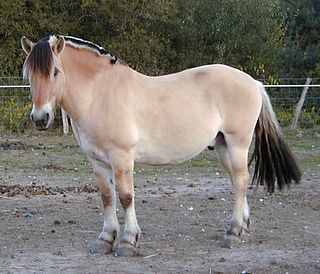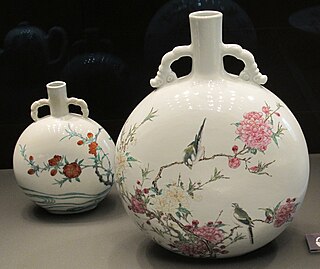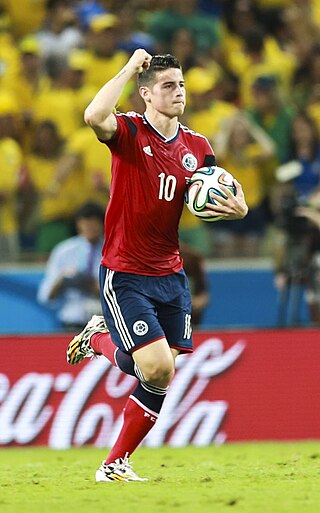
Blue is one of the three primary colours in the RYB colour model, as well as in the RGB (additive) colour model. It lies between violet and cyan on the spectrum of visible light. The term blue generally describes colours perceived by humans observing light with a dominant wavelength between approximately 450 and 495 nanometres. Most blues contain a slight mixture of other colours; azure contains some green, while ultramarine contains some violet. The clear daytime sky and the deep sea appear blue because of an optical effect known as Rayleigh scattering. An optical effect called the Tyndall effect explains blue eyes. Distant objects appear more blue because of another optical effect called aerial perspective.

Orange is the colour between yellow and red on the spectrum of visible light. Human eyes perceive orange when observing light with a dominant wavelength between roughly 585 and 620 nanometres. In traditional colour theory, it is a secondary colour of pigments, produced by mixing yellow and red. In the RGB colour model, it is a tertiary colour. It is named after the fruit of the same name.

A blazer is a type of jacket resembling a suit jacket, but cut more casually. A blazer is generally distinguished from a sport coat as a more formal garment and tailored from solid colour fabrics. Blazers often have naval-style metal buttons to reflect their origin as jackets worn by boating club members.

The Fjord or Norwegian Fjord Horse is a relatively small but very strong horse breed from the mountainous regions of western Norway. It is an agile breed of light draught horse build. It is always dun in colour, with five variations in shade recognised in the breed standard. One of the world's oldest breeds, it has been used for hundreds of years as a farm horse in Norway, and in modern times is popular for its generally good temperament. It is used both as a harness horse and under saddle.

Famille jaune, noire, rose, verte are terms used in the West to classify Chinese porcelain of the Qing dynasty by the dominant colour of its enamel palette. These wares were initially grouped under the French names of famille verte, and famille rose by Albert Jacquemart in 1862. The other terms famille jaune (yellow) and famille noire (black) may have been introduced later by dealers or collectors and they are generally considered subcategories of famille verte. Famille verte porcelain was produced mainly during the Kangxi era, while famille rose porcelain was popular in the 18th and 19th century. Much of the Chinese production was Jingdezhen porcelain, and a large proportion were made for export to the West, but some of the finest were made for the Imperial court.

Buff is a light brownish yellow, ochreous colour, typical of buff leather. Buff is a mixture of yellow ochre and white: two parts of white lead and one part of yellow ochre produces a good buff, or white lead may be tinted with French ochre alone.
Payne's grey is a dark blue-grey colour used in painting. Originally a mixture of iron blue, yellow ochre and crimson lake, Payne's grey now is often a mixture of blue and black, or of ultramarine and burnt sienna. The colour is named after William Payne, who painted watercolours in the late 18th century, who most likely developed the colour while trying to produce a mixer that was less intense than black. Payne's grey was deemed an obsolete term in the early 19th century, but is still used by artists today.

The Dutch rabbit, historically known as Hollander or Brabander, is a breed of domestic rabbit. It is easily identifiable by its characteristic color pattern and was once the most popular of all rabbit breeds. However, after dwarf rabbits were developed, the popularity of the Dutch rabbit declined. Nevertheless, the Dutch rabbit remains one of the top ten most popular breeds worldwide.

Hand-colouring refers to any method of manually adding colour to a monochrome photograph, generally either to heighten the realism of the image or for artistic purposes. Hand-colouring is also known as hand painting or overpainting.
Saffron is a shade of yellow or orange, the colour of the tip of the saffron crocus thread, from which the spice saffron is derived. The hue of the spice saffron is primarily due to the carotenoid chemical crocin.

Foundation is a liquid, cream, or powder makeup applied to the face and neck to create an even, uniform color to the complexion, cover flaws and, sometimes, to change the natural skin tone. Some foundations also function as a moisturizer, sunscreen, astringent or base layer for more complex cosmetics. Foundation applied to the body is generally referred to as "body painting" or "body makeup".

Animal colouration is the general appearance of an animal resulting from the reflection or emission of light from its surfaces. Some animals are brightly coloured, while others are hard to see. In some species, such as the peafowl, the male has strong patterns, conspicuous colours and is iridescent, while the female is far less visible.

The history of British Rail's corporate liveries is quite complex. Although from the mid-1960s to the 1980s the organisation was associated with "Rail Blue", a number of other schemes were also used, especially when it was split into operating units or "sectors" in the mid-1980s.
Colours of the Syrian hamster can be described in three ways: as "self", "agouti" or "combinations". Self colours are a consistent coat colour with the same colour topcoat and undercoat. Agouti hamsters have a ticked coat, where each individual fur is banded in different colours. Agouti hamsters also have "agouti markings" which consist of dark cheek markings, a dark marking on the head, and a light underbelly. Combinations are produced when two self or agouti colours are present.

Varieties of the color blue may differ in hue, chroma, or lightness, or in two or three of these qualities. Variations in value are also called tints and shades, a tint being a blue or other hue mixed with white, a shade being mixed with black. A large selection of these colors is shown below.

Shades of white are colors that differ only slightly from pure white. Variations of white include what are commonly termed off-white colors, which may be considered part of a neutral color scheme.

Structural coloration in animals, and a few plants, is the production of colour by microscopically structured surfaces fine enough to interfere with visible light instead of pigments, although some structural coloration occurs in combination with pigments. For example, peacock tail feathers are pigmented brown, but their microscopic structure makes them also reflect blue, turquoise, and green light, and they are often iridescent.

Sky blue refers to a collection of shades comparable to that of a clear daytime sky. Typically it is a shade of cyan or light teal, though some iterations are closer to light blue. The term is attested from 1681. A 1585 translation of Nicolas de Nicolay's 1576 Les navigations, peregrinations et voyages faicts en la Turquie includes "the tulbant [turban] of the merchant must be skie coloured".

Away colours or road colours are a choice of coloured clothing used in team sports. They are required to be worn by one team during a game between teams that would otherwise wear the same colours as each other, or similar colours. This change prevents confusion for officials, players, and spectators. In most sports, it is the visiting or road team that must change.














